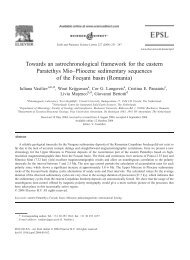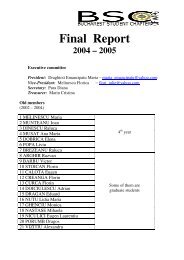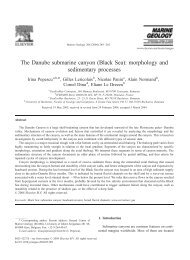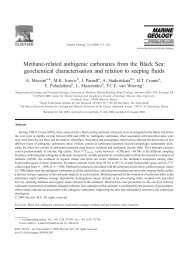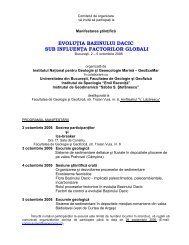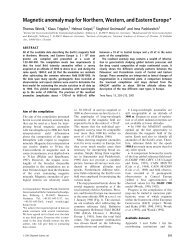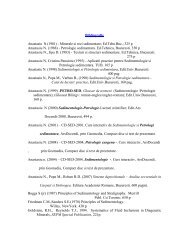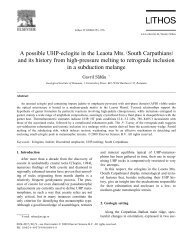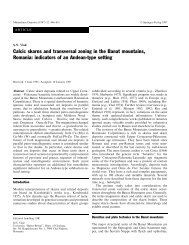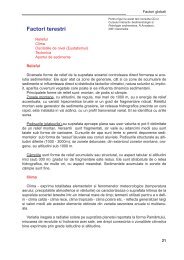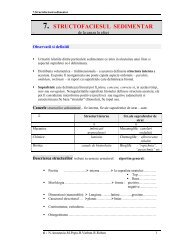Lateglacial and early Holocene vegetation ... - geo.edu.ro
Lateglacial and early Holocene vegetation ... - geo.edu.ro
Lateglacial and early Holocene vegetation ... - geo.edu.ro
You also want an ePaper? Increase the reach of your titles
YUMPU automatically turns print PDFs into web optimized ePapers that Google loves.
L. Bj .orkman et al. / Quaternary Science Reviews 21 (2002) 1039–1059 1043<br />
Table 2<br />
AMS 14 C dates f<strong>ro</strong>mPreluca Tiganului <st<strong>ro</strong>ng>and</st<strong>ro</strong>ng> Steregoiu. Calibrated ages at 72s as derived by the OxCal 3.5 computer p<strong>ro</strong>gram are also given (B<strong>ro</strong>nk<br />
Ramsey, 1995). The date used to construct a ch<strong>ro</strong>nology for the pollen diagrams (Figs. 2 <st<strong>ro</strong>ng>and</st<strong>ro</strong>ng> 3) is either, a mid-point of the calibrated interval (at<br />
72s), or an adjusted date, which takes into account the calibration curve <st<strong>ro</strong>ng>and</st<strong>ro</strong>ng> the most p<strong>ro</strong>bable interval (at both 71s <st<strong>ro</strong>ng>and</st<strong>ro</strong>ng> 72s), <st<strong>ro</strong>ng>and</st<strong>ro</strong>ng> the<br />
stratigraphic position of the sample (assuming a <strong>ro</strong>ughly uniform sedimentation rate, see ch<strong>ro</strong>nology chapter)<br />
14 C Lab. number Depth (m) Dated material<br />
14 C age BP Calibrated years BP Date used to construct<br />
a ch<strong>ro</strong>nology (cal. years BP)<br />
(A) Preluca Tiganului<br />
Ua-16341 5.25–5.205 Charcoal, wood,<br />
8565790 9900–9400 9650 at 5.23 m<br />
bark<br />
Ua-16340 6.07–6.03 Wood 91857100 10,640–10,610 (1.4%), 10,450 at 6.05 m<br />
10,590–10,180 (94%)<br />
Ua-16339 6.34–6.29 Wood 9680790 11,250–10,700 10,900 at 6.315 m<br />
Ua-16338 6.43–6.385 Wood 9685795 11,250–10,700 11,150 at 6.41 m<br />
Ua-16337 6.725–6.68 Peat (washed) 10,240790 12,750–11,350 11,400 at 6.70 m<br />
Ua-16336 7.09–7.045 Wood 10,2657115 12,850–11,350 11,675 at 7.07 m<br />
Ua-16335 7.36–7.315 Peat (washed) 10,1907110 12,750–11,250 11,750 at 7.34 m<br />
Ua-16334 8.285–8.24 Picea needles,<br />
11,5157115 13,850–13,150 13,450 at 8.26 m<br />
bark, wood<br />
Ua-16333 8.73–8.70 Twigs 11,9507125 14,350–13,550 13,950 at 8.715 m<br />
Ua-16332 9.19–9.14 Picea needles, cone 12,0657115 y–14,626 (45.7%), 14,100 at 9.165 m<br />
14,350–13,800 (47.5%),<br />
13,750–13,650 (2.2%)<br />
Ua-16331 9.45–9.40 Picea needles 12,2307105 15,450–14,550 (62.5%), 14,200 at 9.425 m<br />
14,450–14,050 (29.7%),<br />
13,950–13,750 (3.2%)<br />
Ua-16330 9.905–9.85 Wood 12,2507105 15,450–14,550 (63.9%), 14,400 at 9.88 m<br />
14,450–14,050 (29.1%),<br />
13,950–13,850 (2.4%)<br />
(B) Steregoiu<br />
Ua-16329 3.28–3.23 Picea needles 8300785 9490–9030 9260 at 3.255 m<br />
Ua-16328 4.05–4.004 Picea needles,<br />
9130795 10,600–9900 10,250 at 4.03 m<br />
twigs, leaf fragments<br />
Ua-16327 4.36–4.32 Picea needles 9530785 11,200–10,550 10,700 at 4.34 m<br />
Ua-16326 4.544–4.50 Wood fragments 96657110 11,250–10,600 11,100 at 4.52 m<br />
Ua-16325 4.694–4.64 Charcoal, leaves, 10,3257150 12,850–11,350 11,400 at 4.67 m<br />
wood<br />
Ua-16324 5.164–5.12 Wood fragments 10,9107105 13,200–12,800 (80.6%), 12,150 at 5.14 m<br />
12,750–12,600 (14.8%)<br />
Ua-16323 5.324–5.274 Leaves, Picea<br />
needle, wood<br />
12,3657115 15,450–14,050 14,000 at 5.30 m<br />
AMS 14 C measurements were carried out on terrestrial<br />
plant mac<strong>ro</strong>fossils (Table 2). The samples were<br />
treated with 1% HCl (6 h below boiling point) <st<strong>ro</strong>ng>and</st<strong>ro</strong>ng> 0.5%<br />
NaOH (1 h at 601C), then dried at 1001C overnight in<br />
small glass bottles <st<strong>ro</strong>ng>and</st<strong>ro</strong>ng> sent to the AMS facility in<br />
Uppsala, Sweden. F<strong>ro</strong>mthe first site, Preluca Tiganului,<br />
12 samples were dated, <st<strong>ro</strong>ng>and</st<strong>ro</strong>ng> f<strong>ro</strong>m the second, Steregoiu,<br />
seven samples were dated.<br />
4. Results <st<strong>ro</strong>ng>and</st<strong>ro</strong>ng> interpretations<br />
4.1. Lithostratigraphy<br />
Simplified stratigraphies for the analysed p<strong>ro</strong>files<br />
f<strong>ro</strong>mPreluca Tiganului (0–9.90 m) <st<strong>ro</strong>ng>and</st<strong>ro</strong>ng> Steregoiu<br />
(0–5.92 m) are presented in Table 1 (see also lithology<br />
columns in the pollen diagrams, Figs. 4 <st<strong>ro</strong>ng>and</st<strong>ro</strong>ng> 5).<br />
The stratigraphy for Preluca Tiganului indicates<br />
that the crater lake became overg<strong>ro</strong>wn relatively<br />
<st<strong>ro</strong>ng>early</st<strong>ro</strong>ng> (at 8.70 m), when carr peat started to accumulate<br />
(Fig. 4). F<strong>ro</strong>mthis level on the site has been a mire,<br />
initially with carr <st<strong>ro</strong>ng>vegetation</st<strong>ro</strong>ng>, but f<strong>ro</strong>m6.13 m<br />
<st<strong>ro</strong>ng>and</st<strong>ro</strong>ng> upwards, it has been a more or less open fen.<br />
Since the bottomsediment in the cored p<strong>ro</strong>file is fine<br />
detritus gyttja, this may imply that the corer did not<br />
penetrate into the oldest sediments in the basin, which<br />
may be more or less mine<strong>ro</strong>genic (cf. stratigraphy<br />
for Steregoiu) (Wohlfarth et al., in press). Between<br />
9.90 <st<strong>ro</strong>ng>and</st<strong>ro</strong>ng> 8.70 mdifferent types of lake sediment were<br />
deposited (Table 1), varying f<strong>ro</strong>mfine <st<strong>ro</strong>ng>and</st<strong>ro</strong>ng> coarse<br />
detritus gyttja, to clay gyttja <st<strong>ro</strong>ng>and</st<strong>ro</strong>ng> gyttja peat. These



